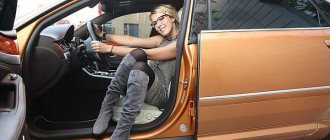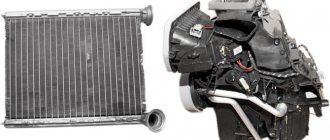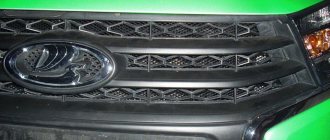The radiator protection of the Lada Vesta car is used to protect it from dirt, and the grille insulation is used so that the engine cools down more slowly and the winter cold is unaffected. The Lada Vesta has a nice plastic radiator grille. It has large cells, design has defeated rationality. Over time, the honeycombs of the cooling system will become clogged with all sorts of rubbish: sand, dirt, flies and beetles, ending with fine gravel, which causes significant damage to the car’s radiator. It is advisable to modify the factory radiator mesh with an additional mesh. Read the article and find out how to protect and insulate your radiator grille.
Branded radiator protection
Designed specifically for Lada Vesta. Summer protection is made of a 4-component set for the radiator grille + two air intake elements. Made of durable aluminum, the protective mesh has optimal holes and is nicely edged with plastic. In the kit, the manufacturer has provided all the necessary supplies, from instructions to a screwdriver. Fastening is done using latches, the description in the instructions is extremely clear, you don’t need to remove or disassemble anything to install the protective grilles. Simple manipulations, and the car becomes prettier right before your eyes. Installation - at temperatures >+10 degrees Celsius. Looks effective. Minus - a little expensive.
Table of sizes and articles of the meshmsk mesh
| Cell size | Sheet size | Color | ||||
| Black | Silver | Red | Blue | White | ||
| #6 | ||||||
| 150X1000 | SB-061511 | SS-061512 | SR-061513 | SBl-061514 | SW-061515 | |
| 250X1000 | SB-062511 | SS-062512 | SR-062513 | SBl-062514 | SW-062515 | |
| 375X1000 | SB-063711 | SS-063712 | SR-063713 | SBl-063714 | SW-063715 | |
| 500X1000 | SB-065011 | SS-065012 | SR-065013 | SBl-065014 | SW-065015 | |
| 200X1200 | SB-062021 | SS-062022 | SR-0662023 | SBl-062024 | SW-062025 | |
| 400X1200 | SB-064021 | SS-064022 | SR-064023 | SBl-064024 | SW-064025 | |
| #10 | ||||||
| 150X1000 | SB-101511 | SS-101512 | SR-101513 | SBl-101514 | SW-101515 | |
| 250X1000 | SB-102511 | SS-102512 | SR-102513 | SBl-102514 | SW-102515 | |
| 375X1000 | SB-103711 | SS-103712 | SR-103713 | SBl-103714 | SW-103715 | |
| 500X1000 | SB-105011 | SS-105012 | SR-105013 | SBl-105014 | SW-105015 | |
| 200X1200 | SB-102021 | SS-102022 | SR-102023 | SBl-102024 | SW-102025 | |
| 400X1200 | SB-104021 | SS-104022 | SR-104023 | SBl-104024 | SW-104025 | |
| #15 | ||||||
| 150X1000 | SB-151511 | SS-151512 | SR-151513 | SBl-151514 | SW-151515 | |
| 250X1000 | SB-152511 | SS-152512 | SR-152513 | SBl-152514 | SW-152515 | |
| 375X1000 | SB-153711 | SS-153712 | SR-153713 | SBl-153714 | SW-153715 | |
| 500X1000 | SB-155011 | SS-155012 | SR-155013 | SBl-155014 | SW-155015 | |
| 200X1200 | SB-152021 | SS-152022 | SR-152023 | SBl-152024 | SW-152025 | |
| 300x1200 | SB-153021 | SS-153022 | SS-153023 | SBL-153024 | ||
| 400X1200 | SB-154021 | SS-154022 | SR-154023 | SBl-154024 | SW-154025 | |
| #20 | ||||||
| 150-1000 | SB-201511 | SS-201512 | SR-201513 | SBl-201514 | SW-201515 | |
| 250X1000 | SB-202511 | SS-202512 | SR-202513 | SBl-202514 | SW-202515 | |
| 375-1000 | SB-203711 | SS-203712 | SR-203713 | SBl-203714 | SW-203715 | |
| 500X1000 | SB-205011 | SS-205012 | SR-205013 | SBl-205014 | SW-205015 | |
| #25 | ||||||
| 150X1000 | SB-251511 | SS-251512 | SR-251513 | SBl-251514 | SW-251515 | |
| 250X1000 | SB-252511 | SS-252512 | SR-252513 | SBl-252514 | SW-252515 | |
| 375X1000 | SB-253711 | SS-253712 | SR-253713 | SBl-253714 | SW-253715 | |
| 500X1000 | SB-255011 | SS-255012 | SR-255013 | SBl-255014 | SW-255015 | |
| 200X1200 | SB-252021 | SS-252022 | SR-252023 | SBl-252024 | SW-252025 | |
| 400X1200 | SB-254021 | SS-254022 | SR-254023 | SBl-254024 | SW-254025 | |
Universal
This cover for the VAZ 2180 radiator will cost less, but the mesh is installed from the inside, you need to take the trouble to disassemble it. You can't do it without removing the bumper with the standard plastic grille; you'll have to do some work. What distinguishes this method of protection from the cheapest version of protecting a car’s cooling system is the presence of an edging around the mesh fastenings (brackets). Choice by article number: VS-ZSRLVES or ZR.LAD.VES.15
. It is called “Arrow” and is installed at the top of the bumper and down.
The price of such a mesh, upper and lower, in a set, is about 3,000 rubles. You can find them cheaper separately.
Do it yourself - how to make protection anyway
For garage Samodelkin, saving budget, manufacturers have prepared an extremely inexpensive option for protecting the cooling radiator. This is an aluminum mesh, which should be independently attached to the plastic grille and bumper from the inside. The cell size is usually 10-15 mm. The cost is much cheaper than branded, universal ones for the Lada Vesta, purely a cover without frills and claims to classic tuning. Garage technicians will have to scratch their heads trying to figure out how best to mount this thing. It is necessary to take two pieces of mesh, the sizes sold are as follows, for a couple of parts (grille and air intake), there is unlikely to be enough material.
Body
The fit of the fog lamp holders leaves much to be desired on both Vestas: on the brown one, a seal sticks out from the joint of the parts, and on the red one there is an open gap.
Sedans look better with side windows that visually continue the glazing of the rear doors. And they go to Vesta. But the gluing of these triangles leaves much to be desired - they sit unevenly and asymmetrically.
The red Vesta has a gap between the trunk lid and the rear fender on the left - 3 mm, and on the right - 5.5 mm, almost twice as much. When resold, such a Lada will most likely be mistaken for a poorly restored one after an accident.
In both cars, the fog lamp holders do not fit well into the bumper openings: on the red one there are gaping gaps, on the other the seal sticks out sloppily. Mud flaps and fender liners do not fit tightly to the surface of the front fenders on both cars. On brown, the mudguards protrude more, on red - the fender liners.
One Vesta's front mudguards are clearly bulging. The other one has no mudguards yet, but the fender liners are not tight enough.On the brown Vesta, the rear fender liners are made of two parts of molded non-woven material and sewn together with ordinary rusting steel clips. Moreover, their number in the fender liners of the right and left arches is different.
The inside handle of the front passenger door on a brown car is installed with a gap of more than 3 mm. The rest fit tightly.
A cooled glove box appeared on the Lada for the first time. But the execution is lame. The air supply nozzle is half blocked by the foam seal that has come out.
The hood lock lever dangles on the axis, bends when pressed, and periodically jams
All listed defects are assembly defects
It doesn’t matter where the conveyor is located - in Tolyatti or Izhevsk, the plant simply must eliminate such defects quickly
Are there any design flaws? There will be some.
When tightened with bolts, the metal inserts of the bushings securing the intake resonator cut the plastic lining of the upper cross member.
The quality of components is also poor. The cars have covered less than 10 thousand kilometers each, but the windows of the front doors are already badly scratched. This may indicate both insufficient hardness of the glass and an unsuccessful design of their external seals. In this case, there are more questions about the glass supplied by the Turkish Sisecam Group. Why did you change supplier? There are far fewer comments about the products of the Bor Glass Factory, which are installed on Tolyatti cars of other models. In front of the editorial office are the seasoned Granta, Kalina and Datsun mi-DO - not a scratch on the side windows.
Dressing the car for winter
In winter, in the northern expanses, severe Siberian frosts, the car eats gasoline more actively and freezes faster than you want. It is advisable to insulate the car for winter to feel more comfortable. Attempts to insert a cardboard do not go well; you cannot insert a cardboard into a Lada vesta, and to cover it on top is a “collective farm”. We have to turn to ready-made insulation solutions.
Insulation from YarPlast code: VS-ZIM-Z
lower price: from 550 rub. The top one will cost from 890 rubles.
The winter radiator protection is made of strong black plastic; it fits into the interior of the Lada Vesta and does not disturb the harmony. The engine temperature rises quickly, it cools down more slowly - it uses gasoline more economically. This insulation, like summer insulation, consists of two parts: for the grille and the air intake. When it thaws, it is better to remove the top part if you do not want to drive in the fan. There shouldn't be any problems installing this device; it's fastened with clips and standard bolts. It is recommended to apply adhesive tape or insulating tape to the bumper in the place where the lower part of the shield may come into contact, stripping off the paint.
Should you close the Lada Vesta radiator in winter: scientific and experimental facts
Science says that a deviation of the coolant temperature needle towards lower values is also not good - fuel consumption increases and the process of carbon formation intensifies. Common sense dictates: a lower coolant temperature will negatively affect the operation of the heater, which takes heat from the radiator integrated into the cooling system.
Theorists' Arguments
The simple question of how to close the radiator grill on a Vesta sometimes arises blindly, say, on the advice of a neighbor in the garage or a work colleague. It is clear that the general recommendations on this matter will be in agreement with the instructions of friends - insert a piece of cardboard in front of the radiator and you will feel how:
- The engine warms up faster while driving.
- The operating temperature of the engine on the highway is stabilized.
- The cabin will become warmer.
Reviews from those who have insulated themselves
How relevant are the stereotypical advantages for the Lada Vesta, whose engines are, by definition, hot? The conversation is serious, because how many car enthusiasts want to assert themselves by explaining the operation of the thermostat and the classic postscript, they say, a normally working thermostat provides optimal temperature conditions. No one has canceled physics, which is what the experience of newsmakers says - the “face” needs to be insulated. Naturally, not without reservations on the technological side. So the optimal temperature for the cover is -20°C. If it gets warmer, don’t expect trouble, but the cooling system fan will work. This is almost tightly.
It is possible earlier, but in moderation. It has been noticed that the covered bottom helps stabilize the thermal regime even at -10…-12°C. Without insulation, the sensor shows about 80-85°C while driving. There is no noticeable discomfort in the cabin, but the stove is already working at its limit.
Which radiator grille for Vesta to choose
The radiator grille of the Lada Vesta without a badge decorates the appearance. The domestic car looks like it came from Europe. Removing the emblem from the front surface of the hood requires replacing the grille.
AvtoVAZ offers several options for grilles for Vesta.
Grate for the cold season. Consists of two components. Protects against penetration of cold air masses into the radiator. Estimated cost – 1200-1500 rubles. Replacement is carried out at an air temperature of at least -3 degrees.
Installation
The algorithm for self-installation of Lada Vesta radiator protection depends on what product was purchased. And if so, then all three cases need to be analyzed separately.
Installing proprietary protection
There are almost never any difficulties with it, since the installation process is described in the instructions that come with each kit. The main thing is not to be lazy and read it before installation, and not after. The big advantage of this product is that there is no need to remove the Lada Vesta bumper.
Installation of the protection should take place at an air temperature of +10 ° C and above, and the upper, lower and middle sections are installed differently. In the instructions on the diagram, it is immediately clear that only the upper part is equipped with latches both at the bottom and at the top, while the other components have only bottom fastenings.
Installation instructions.
Radiator screen
As already noted, a total of 4 parts are included in the kit for installation in the radiator grille - the top, 2 middle and bottom.
Upper section
This part is placed in pairs. The direction is from left to right, you need to navigate according to the attached diagram. First, you need to direct the latch (lower) into the cell marked in the diagram, then insert the upper stop and recess the latch into the cell. Everything needs to be done smoothly so as not to break the fasteners.
Next, you should arm yourself with a screwdriver or an awl, which you insert into the hole in the mesh, and use it to press the latches on the back side, snapping them completely into place. To check the quality of fastening, you need to smoothly pull the section towards you. In the end, all that remains is to align it with the contour of the lattice.
Middle sections
There are two of these parts. To install, you need to insert the clamps into the holes marked in the diagram. You need to work from the center to the edge. When the clips are snapped into place, all that remains is to check the quality of the fastening and smoothly align the section. The second one is placed in the same way.
Bottom section
Installation of this part of the Vesta radiator protection occurs in the same way as the upper one. You need to place it from left to right, smoothly inserting the clamps into the marked holes. When they are all latched, all that remains is to align the section.
Air intake
In this case, there are only two parts, and the installation algorithm for them is the same. You can start working from any edge. There are fastenings at the bottom and top of each section, which are used for fixation. For greater convenience, it is recommended to arm yourself with a screwdriver or an awl.
The process of installing Vesta radiator protection into the air intake is clearly demonstrated in the video
Installing homemade protection
In this case, it all starts with removing the front bumper of Vesta, which forces us to take a closer look at this point. It’s worth noting right away that dismantling the front bumper of Vesta is strongly recommended to be done by two people, since the dimensions of the element are considerable, so there is always a risk of scratching either the bumper itself or the wings of the car. To work, it is recommended to either drive the car onto an overpass, or jack it up, or simply drive it onto a stand so that the front end is lifted up a little.
Removing the front bumper of Lada Vesta yourself
Tools required for work:
- Ratchet;
- Head 10;
- Torx bit 20;
- Torx 30 bit.
It all starts with the license plate, which must be removed, since there are mounting bolts underneath it. Next, you should open the hood and unscrew the 2 bolts securing the plastic housing to the bumper - for this you use a ratchet and a 10mm socket.
First, remove the 2 bolts from the top.
Once they are unscrewed, you can begin to work on the bolts that were hidden under the license plate. To do this, you will need a Torx 20 sprocket (regular wrench or socket).
Then comes the turn of the bolts under the license plate.
Then we proceed to unscrew the bolts in the wheel arch (under the wings) - there are 2 of them per side. This is done with the same Torx 20 sprocket.
Next, you need to unscrew 4 more bolts from the bottom of the bumper, which secure it to the body. To do this, you will need a Torx 30 sprocket. You also need to unscrew 4 more bolts with a Torx 20 sprocket - from the bottom of the bumper, 2 on each side. They secure the edges of the bumper to the plastic shields. That's it for now with the bolts.
Next you need to remove the bumper itself. First, both sides need to be removed from the grooves at the junction of the bumper and the front fender. It is worth noting that the edges of the Vesta bumper fit quite tightly in the grooves. If you have to remove it yourself, you need to work extremely carefully, and lay a mattress or cloth in front of the car in case the bumper falls - so that it does not get scratched.
All that remains is to unscrew 4 more bolts under the hood. They are unscrewed with a Torx 30 sprocket. If you work alone, they need to be unscrewed last and the last bolt should be the middle one - the one located opposite the hood lock. If with a partner, you can do it at the very beginning. Next you need to remove the bumper and get ready to install the mesh. Naturally, if you have fog lights, you need to disconnect the wires from them.
The process of independently removing the front bumper of a Lada Vesta with all the explanations and details is demonstrated in this video
Prepare and install the grid
After the bumper is removed, you can begin making the protection. There is nothing complicated here - you just need to attach the mesh to the back of the radiator grille or air intake, mark the outline and cut it out with scissors. The main thing is that when cutting out a piece for the air intake, it is important not to forget to cut out the mesh with areas for the screws.
Once the mesh is cut, it needs to be secured. There will be no problems with the product for the air intake, since the fastening is carried out using standard self-tapping screws on the reverse side (which is why there should be areas for them in the mesh).
The mesh for the radiator grille is a little more complicated, since it will have to be fixed with plastic clamps matched to the color of the products. As practice shows, clamps are the best option.
When the mesh is securely fixed, all that remains is to put the bumper back. Assembly is carried out in reverse order.
Installation of the mesh on the reverse side is shown in the story
Installation of universal protection
This option is similar to that with a homemade mesh, but with the difference that ready-made products are installed, and they also come with fasteners and instructions. First you need to remove the Vesta bumper. Fixation occurs with bolts into brackets on the mesh. However, some duplicate this fastening with clamps for greater reliability. At the end the bumper is put back.
As you can see, installing radiator protection for the Lada Vesta is fully justified, since the aluminum mesh will become a reliable barrier in the way of litter, pebbles, insects, pieces of ice and other things.
Installation of such protection is facilitated by the presence of brackets.
But the choice of installation option is individual for everyone. Some will prefer branded protection as the most attractive. Others will do everything themselves from the mesh, rejoicing at the opportunity to work with the machine and save money, or they will purchase a universal product so as not to waste time. Complete freedom of choice!
Outer mesh
The mesh edging is made of high-quality plastic with fastenings for installation. Fixation takes 2-4 minutes. The cost depends on the material from which the mesh is made. Price – 700 – 3000 rubles. Chrome trim on the bottom edge of the grille. Made of steel, not subject to corrosion. Cost – 4500 rubles.
Car owners most often purchase plastic grilles. The choice is explained by ease of installation, resistance to temperature conditions, a large selection of colors, and strong design.
Grill installation
Installation of plastic products requires adherence to technology and accuracy. The process is long and labor-intensive. An assistant will be required to complete the work.
Algorithm of actions
- Remove the bumper and place it on a soft surface to prevent damage;
- Remove the six retaining bolts. In the upper part, remove the small bolts - six pieces, the large bolt in the center of the oval;
- Remove the grille, do not forget about the plastic latches;
- Install the mount on the new element;
- Use two bolts to connect the new plastic grille to the inside;
- Attach the resulting structure to the main part;
- Secure with the six removed bolts;
- Install four small bolts, the large bolt in the middle.











